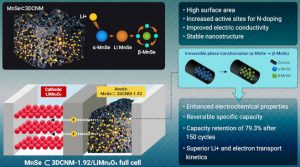
Manganese selenide would have promising characteristics as an anode material for lithium ion batteries, if only it didn’t swell almost 160% during charging-discharging cycles, breaking apart the electrode.
Now researchers from the Korea Maritime and Ocean University have found a way to embed MnSe in a 3D carbon nanosheet matrix where its expansion can be tamed.
“We focused on manganese selenide, an affordable transition metal compound known for its high electrical conductivity and applicability in developing semiconductors and supercapacitors, as a possible candidate for the advanced Li-ion battery anode,” said engineer Jun Kang.
They used a sol–gel and selenation route, described by the team as “facile” – chemist speak for ‘like falling off a log’.
The resulting anode material has uniform MnSe nanoparticles anchored in the carbon nanosheet matrix (CNM) and had been named ‘MnSe ⊂ 3DCNM’.
As well as taming the swelling, the structure has a high surface area and other advantages “leading to full lithiation – delithiation reactions, excellent electrochemical kinetics and buffer volume expansion of MnSe nanoparticles”, according to a paper which describes the work (see below).
A particular variant – MnSe ⊂ 3DCNM-1.92 – as a lone electrode, has a stable reversible capacity of 665.5mAh/g after 200 cycles and a sustained coulombic efficiency close to 100%.
Combined with a LiMn2O4 cathode in a full battery, “the team observed that MnSe ⊂ 3DCNM-1.92 continued to demonstrate superior electrochemical properties, including superior lithium ion and electron transport kinetics”, according to the university.
“Using a conducive filler scaffold, we have developed an anode that boosts the battery performance while simultaneously allowing reversible energy storage,” said Kang. “This strategy can serve as a guide for other transition metal selenides with high surface areas and stable nanostructures, with applications in storage systems, electrocatalysis, and semiconductors.”
Korea Maritime and Ocean University worked with Pusan National University.
The work is described in ‘Facile synthesis of manganese selenide anchored in three-dimensional carbon nanosheet matrix with enhanced lithium storage properties‘, published in the Chemical Engineering Journal.